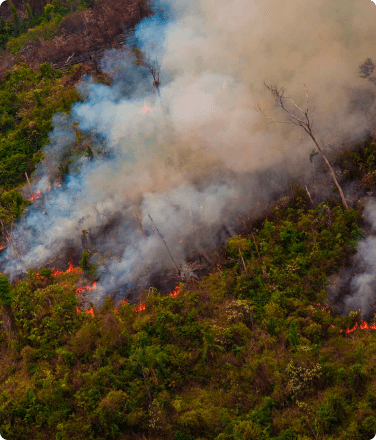BY KIM CHAIX
“The first wave took the elders. The second wave is taking our children.”
– Nara Baré, leader of the Coordination of the Indigenous Organizations of the Brazilian Amazon (Coordenação das Organizações Indígenas da Amazônia Brasileira, or COIAB)
How the new COVID-19 variant is affecting indigenous peoples
“Fifteen people have died in the past week and I’m afraid to leave my house,” says Francisco “Pancho” Hernandez Cayetano, an indigenous leader who lives in the Peruvian town of Caballococha, deep in the Amazon forest and a stone’s throw from the tri-border area linking Colombia, Brazil, and Peru.
Pancho leads the Federation of the Ticuna and Yaguas Communities of the Lower Amazon (Federación de Comunidades Ticunas y Yaguas del Bajo Amazonas, or FECOTYBA) whose territory stretches across 70,616.5 hectares (roughly 174,497 acres) of the Amazon rainforest in Peru’s northern province of Loreto. FECOTYBA is a close partner of Rainforest Foundation US.

Facing a second—potentially more virulent—wave of COVID-19, Pancho reports that the town’s lone medical clinic has collapsed under the weight of a spike in infections from a mutation of the COVID-19 virus known as the P.1 variant. The situation is not much better 200 miles (125 kms) up-river from Caballococha where the much larger referral hospital in the regional capital of Iquitos is also on the verge of collapse from new COVID-19 infections. Iquitos, the largest city in the Peruvian Amazon, experienced one of the highest infection rates in the world during the initial wave last spring.
“We urgently need food, fuel, medicine, and personal protective equipment,” Pancho said, when asked what the greatest challenges were facing the communities. Pancho also hoped to be able to broadcast messages over the radio urging community members to stay in their territories.
Many questions remain to be answered about the new coronavirus variant. However, for indigenous peoples across the Amazon, and especially in Brazil, the P.1 variant is turning out to be as bad—maybe even worse—than the first wave of COVID-19.
Learn how Rainforest Foundation US has supported indigenous peoples during the pandemic.
A fast spreading variant
The P.1 variant was first identified in November in the city of Manaus in the heart of the Brazilian Amazon. In the two and a half months since it was first detected, the new variant has almost completely displaced the original COVID-19 virus that is most common across the world. The rapid spread of the new variant caught Manaus health authorities by surprise and the city soon ran out of oxygen as new cases—and deaths—skyrocketed over a short period of time.
In January, ten children from the Yanomami people in northern Brazil near the Venezuela border died from COVID-19. It is unclear if the children succumbed to the new variant.

What is clear is that indigenous communities are reporting a higher rate of re-infection and a greater number of infection among their people relative to the broader Brazilian population, according to Nara Baré, a leader of the Coordination of the Indigenous Organizations of the Brazilian Amazon (Coordenação das Organizações Indígenas da Amazônia Brasileira, or COIAB), which represents indigenous peoples across the Brazilian Amazon. Baré mentioned recently that several indigenous leaders were hospitalized with the new variant.
How to slow the spread
Fearing a new wave of infections, Brazil’s neighbors are closing down borders and preparing for a repeat of the lockdown and emergency measures that brought all social and economic activity to a halt a year ago.
More than 1.7 million coronavirus cases have been registered among indigenous people living in the Amazon basin, along with 42,000 deaths since the pandemic began, according to the Coordination of Indigenous Peoples Organizations of the Amazon Basin (Coordinadora de las Organizaciones Indígenas de la Cuenca Amazónica, or COICA), the organization representing indigenous peoples across the Amazon’s nine countries.
Meanwhile, back in Caballococha, when asked if he had a message to share with the rest of the world, Pancho said, “I call on the world to help us keep living our way of life. We protect the forest. Please don’t forget us.”
“We protect the forest. Please don’t forget us”
– Francisco “Pancho” Hernandez Cayetano, President of the Ticuna and Yaguas Communities of the Lower Amazon (Federación de Comunidades Ticunas y Yaguas del Bajo Amazonas, or FECOTYBA)
Why the health of tropical forests and indigenous peoples matter to all of us
Science tells us that tropical forests that are managed by indigenous peoples capture more carbon, harbor more biodiversity, and are generally healthier than any other type of protected area.
Indigenous peoples and local communities possess detailed, time-tested traditional knowledge on maintaining healthy forests, biodiversity and ecosystems. They are often better placed than scientists to provide accurate information on local environmental changes, and are important contributors to the management of forests to provide local to global benefits.
How you can help
To support indigenous peoples’ fight against the P.1 variant outbreak, Rainforest Foundation US is seeking additional support for the Amazon Emergency Fund, which aims to raise urgent funding for COIAB in Brazil. These funds will be used to:
- Construct physical barriers and checkpoints to prevent access to indigenous territories by unauthorized outsiders
- Purchase personal protection equipment (PPEs) and oxygen tanks
- Supply food and disinfectant supplies to indigenous communities
- Cover transport costs to secure medical assistance and shipping costs of supplies



